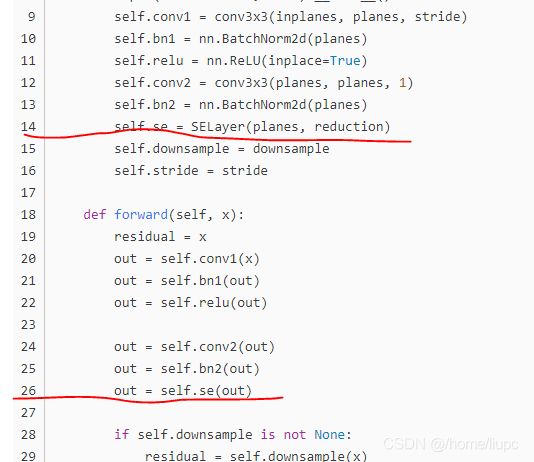SE-ResNet的实现
见:D:\pythonCodes\深度学习实验\4.1_经典分类网络\inference代码汇总\models\se_resnet.py
一、SE-ResNet的实现方法
读了senet这篇论文之后,可以知道senet并没有提出一个新的网络,而是提出了一个即插即用的模块。这个模块叫做SE Block(在实现的时候,为了防止与SEBasicBlock这个名字混淆,叫做SELayer)。
本文希望实现se_resnet网络,也就是将SE Block嵌入到ResNet中形成的网络。se_resnet与resnet的差别就是,就是在BasicBlock(resnet18/34使用的是BasicBlock堆叠,而resnet50/101/152使用的是Bottleneck进行堆叠,这里就以BasicBlock举例,Bottleneck完全一样)中增加了SE Block这个操作。
比如下图,上面是BasicBlock的结构,下图就是SEBasic的结构,就是多出来了一个小圈圈。
通过读resnet的源码,我们知道是通过Resnet()这个类来组织成整个网络的。比如:
resnet34 = ResNet(BasicBlock, [3,4,6,3])
resnet18 = ResNet(BasicBlock, [2,2,2,2])
resnet50 = ResNet(Bottleneck, [3,4,6,3])
resnet101 = ResNet(Bottleneck, [3,4,23,3])
resnet152 = ResNet(Bottleneck, [3,8,36,3])
ResNet()接收两个参数,一个是block,另一个是堆叠的次数layers。只要传入参数,就能组织成一个网络了。比如传入的是BasicBlock,[3,4,6,3]就能得到resnet34了。这个函数就会自动地用3个BasicBlock组成layer1,用4个BasicBlock组成layer2,用6个BasicBlock组成layer3,用3个BasicBlock组成layer3,然后加上头尾等,组成一个网络。
我们可以利用ResNet()函数来构建我们的se_resent网络。只要给ResNet()传入SEBasicBlock和[3,4,6,3]就可以得到se_resnet34了。。
因此最关键的就是实现SEBasicBlock。而SEBasicBlock代码简直就是照抄BasicBlock代码,只要加上SELayer就行了。
(1) SELayer的实现
就是论文中的SE Block,在实现的时候,为了防止与SEBasicBlock这个名字混淆,叫做SELayer。
就是实现下面这个操作:
代码:
class SELayer(nn.Module):
def __init__(self, channel, reduction=16):
super(SELayer, self).__init__()
self.avg_pool = nn.AdaptiveAvgPool2d(1) #全局平均池化,输入BCHW -> 输出 B*C*1*1
self.fc = nn.Sequential(
nn.Linear(channel, channel // reduction, bias=False), #可以看到channel得被reduction整除,否则可能出问题
nn.ReLU(inplace=True),
nn.Linear(channel // reduction, channel, bias=False),
nn.Sigmoid()
)
def forward(self, x):
b, c, _, _ = x.size()
y = self.avg_pool(x).view(b, c) #得到B*C*1*1,然后转成B*C,才能送入到FC层中。
y = self.fc(y).view(b, c, 1, 1) #得到B*C的向量,C个值就表示C个通道的权重。把B*C变为B*C*1*1是为了与四维的x运算。
return x * y.expand_as(x) #先把B*C*1*1变成B*C*H*W大小,其中每个通道上的H*W个值都相等。*表示对应位置相乘。(2)SEBasicBlock的写法
有了SELayer之后,就可以很容易地写SEBasicBlock了。就是照抄BasicBlock代码,只要加上SELayer就行了。
class SEBasicBlock(nn.Module):
expansion = 1
def __init__(self, inplanes, planes, stride=1, downsample=None, groups=1,
base_width=64, dilation=1, norm_layer=None,
*, reduction=16):
# 参数列表里的 * 星号,标志着位置参数的就此终结,之后的那些参数,都只能以关键字形式来指定。
super(SEBasicBlock, self).__init__()
self.conv1 = conv3x3(inplanes, planes, stride)
self.bn1 = nn.BatchNorm2d(planes)
self.relu = nn.ReLU(inplace=True)
self.conv2 = conv3x3(planes, planes, 1)
self.bn2 = nn.BatchNorm2d(planes)
self.se = SELayer(planes, reduction)
self.downsample = downsample
self.stride = stride
def forward(self, x):
residual = x
out = self.conv1(x)
out = self.bn1(out)
out = self.relu(out)
out = self.conv2(out)
out = self.bn2(out)
out = self.se(out)
if self.downsample is not None:
residual = self.downsample(x)
out += residual
out = self.relu(out)
return out就是多了以下两句:
其余的与senet中的basicBlock完全一致。SEBottleneck也是比Bottleneck多了这么一点。
二、完整代码
有了SELayer和SEBasicBlock之后就可以,借用resnet中的ResNet类来搭建SENet网络了。完整的代码如下,包含se_resnet18/34/50/101/152的实现。
# -*- coding: utf-8 -*-
"""
# @file name : se_resnet.py
# @author : https://github.com/moskomule/senet.pytorch
# @date : 2020-08-07
# @brief : se_resnet 模型搭建
"""
import torch
import torch.nn as nn
from torch.hub import load_state_dict_from_url
from torchvision.models import ResNet
# 论文核心 SE Block, 这里称为 SE layer
class SELayer(nn.Module):
def __init__(self, channel, reduction=16):
super(SELayer, self).__init__()
self.avg_pool = nn.AdaptiveAvgPool2d(1) #全局平均池化,输入BCHW -> 输出 B*C*1*1
self.fc = nn.Sequential(
nn.Linear(channel, channel // reduction, bias=False), #可以看到channel得被reduction整除,否则可能出问题
nn.ReLU(inplace=True),
nn.Linear(channel // reduction, channel, bias=False),
nn.Sigmoid()
)
def forward(self, x):
b, c, _, _ = x.size()
y = self.avg_pool(x).view(b, c) #得到B*C*1*1,然后转成B*C,才能送入到FC层中。
y = self.fc(y).view(b, c, 1, 1) #得到B*C的向量,C个值就表示C个通道的权重。把B*C变为B*C*1*1是为了与四维的x运算。
return x * y.expand_as(x) #先把B*C*1*1变成B*C*H*W大小,其中每个通道上的H*W个值都相等。*表示对应位置相乘。
def conv3x3(in_planes, out_planes, stride=1):
return nn.Conv2d(in_planes, out_planes, kernel_size=3, stride=stride, padding=1, bias=False)
class SEBasicBlock(nn.Module):
expansion = 1
def __init__(self, inplanes, planes, stride=1, downsample=None, groups=1,
base_width=64, dilation=1, norm_layer=None,
*, reduction=16):
# 参数列表里的 * 星号,标志着位置参数的就此终结,之后的那些参数,都只能以关键字形式来指定。
super(SEBasicBlock, self).__init__()
self.conv1 = conv3x3(inplanes, planes, stride)
self.bn1 = nn.BatchNorm2d(planes)
self.relu = nn.ReLU(inplace=True)
self.conv2 = conv3x3(planes, planes, 1)
self.bn2 = nn.BatchNorm2d(planes)
self.se = SELayer(planes, reduction)
self.downsample = downsample
self.stride = stride
def forward(self, x):
residual = x
out = self.conv1(x)
out = self.bn1(out)
out = self.relu(out)
out = self.conv2(out)
out = self.bn2(out)
out = self.se(out)
if self.downsample is not None:
residual = self.downsample(x)
out += residual
out = self.relu(out)
return out
class SEBottleneck(nn.Module):
expansion = 4
def __init__(self, inplanes, planes, stride=1, downsample=None, groups=1,
base_width=64, dilation=1, norm_layer=None,
*, reduction=16):
# 参数列表里的 * 星号,标志着位置参数的就此终结,之后的那些参数,都只能以关键字形式来指定。
super(SEBottleneck, self).__init__()
self.conv1 = nn.Conv2d(inplanes, planes, kernel_size=1, bias=False)
self.bn1 = nn.BatchNorm2d(planes)
self.conv2 = nn.Conv2d(planes, planes, kernel_size=3, stride=stride,
padding=1, bias=False)
self.bn2 = nn.BatchNorm2d(planes)
self.conv3 = nn.Conv2d(planes, planes * 4, kernel_size=1, bias=False)
self.bn3 = nn.BatchNorm2d(planes * 4)
self.relu = nn.ReLU(inplace=True)
self.se = SELayer(planes * 4, reduction)
self.downsample = downsample
self.stride = stride
def forward(self, x):
residual = x
out = self.conv1(x)
out = self.bn1(out)
out = self.relu(out)
out = self.conv2(out)
out = self.bn2(out)
out = self.relu(out)
out = self.conv3(out)
out = self.bn3(out)
out = self.se(out)
if self.downsample is not None:
residual = self.downsample(x)
out += residual
out = self.relu(out)
return out
def se_resnet18(num_classes=1_000):
model = ResNet(SEBasicBlock, [2, 2, 2, 2], num_classes=num_classes)
model.avgpool = nn.AdaptiveAvgPool2d(1)
return model
def se_resnet34(num_classes=1_000):
model = ResNet(SEBasicBlock, [3, 4, 6, 3], num_classes=num_classes)
model.avgpool = nn.AdaptiveAvgPool2d(1)
return model
def se_resnet50(num_classes=1_000, pretrained=False):
model = ResNet(SEBottleneck, [3, 4, 6, 3], num_classes=num_classes)
model.avgpool = nn.AdaptiveAvgPool2d(1)
if pretrained:
model.load_state_dict(load_state_dict_from_url(
"https://github.com/moskomule/senet.pytorch/releases/download/archive/seresnet50-60a8950a85b2b.pkl"))
return model
def se_resnet101(num_classes=1_000):
model = ResNet(SEBottleneck, [3, 4, 23, 3], num_classes=num_classes)
model.avgpool = nn.AdaptiveAvgPool2d(1)
return model
def se_resnet152(num_classes=1_000):
model = ResNet(SEBottleneck, [3, 8, 36, 3], num_classes=num_classes)
model.avgpool = nn.AdaptiveAvgPool2d(1)
return model
if __name__ == "__main__":
inputs = torch.randn(2, 3, 224, 224)
model = se_resnet50(pretrained=False)
outputs = model(inputs)
print(outputs.size())
运行结果:
![]()


